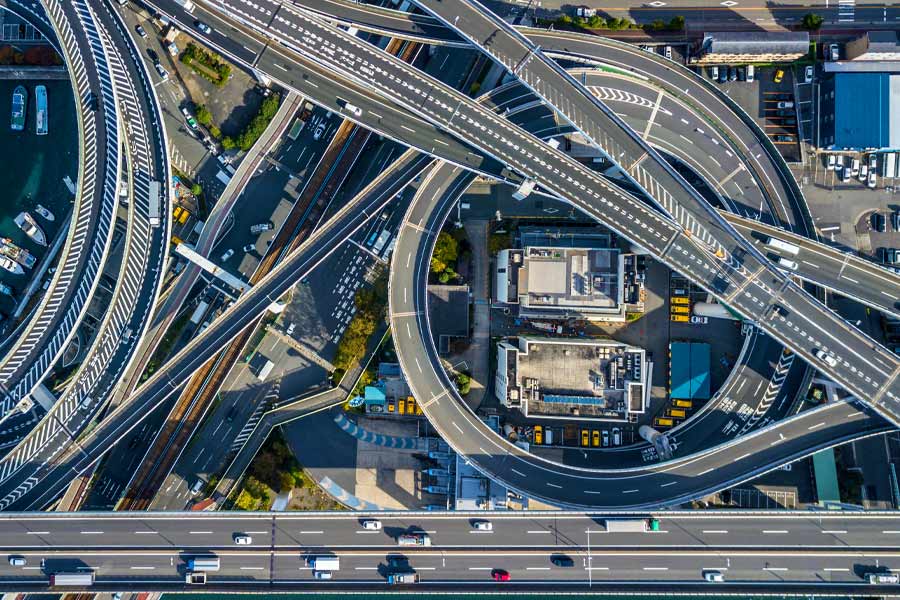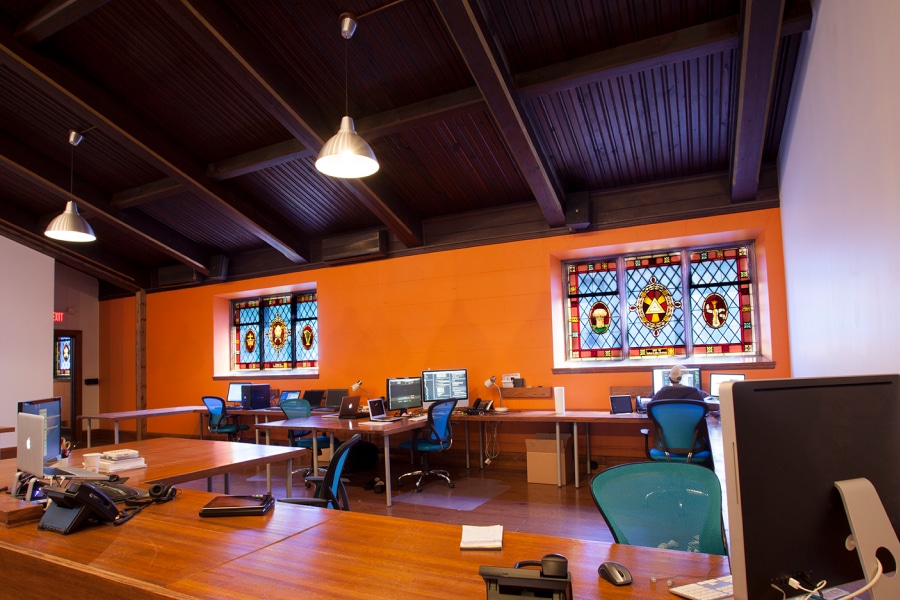Conduct an internet search of current trends in just about any industry—financial services, manufacturing, the grocery business—and you’ll find the opinion leaders focused on technological disruption, the changes wrought by adoption of new, generally digital technology.
If your business is focused on infrastructure projects, you may be asking: Why are we still doing things the same way we did them 30 years ago?
Architects and engineers are taking advantage of digital design technology to the point where it’s revolutionizing the way these professionals work. But contracting for infrastructure projects has stubbornly resisted change. Technology adoption is slow and difficult in construction.
The slow pace of technology adoption in infrastructure projects has caught the attention of the World Economic Forum, the global organization formed in 1971 to focus public-private partnerships on the world’s biggest and thorniest problems. The WEF’s annual conference in Davos, Switzerland, draws heads of state, CEOs and thought leaders, whose pronouncements get global attention.
One of this year’s declarations is that infrastructure worldwide is “one of the least digitally transformed sectors of the economy,” lagging behind other industries in innovation.
The thought leaders in Davos see the digital transformation taking place across industries as a “Fourth Industrial Revolution,” and the WEF has been grappling since 2018 with the question of why the infrastructure sector seems to have been left behind.
Procurement not keeping up
The WEF maintains several mini think-tanks it calls Global Future Councils. According to Joe Losavio, who manages the WEF’s Global Future Council on Infrastructure and its Infrastructure 4.0 initiative, a central inhibitor of technology adoption has been the ossified procurement processes that infrastructure stakeholders use. “Procurement processes and tools have not kept up with the evolution of the technologies now being evaluated for adoption,” Losavio said.
“Part of that is the way we finance infrastructure vs. the way we finance technology,” he added. “Technology is generally equity-financed and infrastructure is debt-financed. Technology financing has evolved rapidly; debt financing for infrastructure hasn’t.”
Losavio draws a distinction between public infrastructure and buildings. “Architects, engineers and construction executives will put up a building with a private-sector customer in mind,” he said. “The consumer and the end-user are often the same. That’s not necessarily true with infrastructure, for which the immediate customer is government.”
Because of the large financial risks associated with infrastructure procurement, the market for large projects hasn’t been as susceptible to technological disruption by new entrants as have other industries, such as financial services. Infrastructure procurement is a long process subject to government funding, and barriers to entry for innovative startup organizations are high.
The Industry 4.0 Initiative has identified a number of issues that have obstructed both companies’ and governments’ adoption of new technologies, and it is in the process of compiling a list of these impediments. “It builds on work we had done previously with our Global Future Council on Infrastructure,” Losavio said.
Encouraging disruption
A technocrat with an advanced degree in International Relations, Losavio is a specialist on the Internet of Things and Urban Transformations team at the WEF.
In November 2019, the WEF published a white paper called “Transforming Infrastructure: Frameworks for Bringing the Fourth Industrial Revolution to Infrastructure.” Chief among the questions it asked: How can technological disruption in the white space of infrastructure be encouraged? And how can the public sector drive innovation in technology while protecting intellectual property?
“We chose infrastructure technology as our main focus area, going into it thinking we would investigate how to create an enabling environment for innovation. We came out of it realizing that innovation itself wasn’t the problem; the problem was adoption of the innovations. We worked with the Global Infrastructure Hub, the G20’s infrastructure knowledge body.”
The Group of Twenty is an international forum for the governments and central bank governors from 19 countries and the European Union. “When the G20 is meeting and they want information about infrastructure so that they can formulate policy, they task the Global Infrastructure Hub to generate that information for them,” Losavio said.
A principal finding has been that infrastructure procurement has been focused inordinately on what is to be built, rather than the problem the project is intended to solve.
“Traditionally we say, ‘We are on a peninsula and there is an island off the coast; please build me a bridge, using bricks, that is this high and this long,’” Losavio said. “We want to encourage more outcome-oriented procurement models. We need a model that says, ‘We need to get from this peninsula to that island. Come back with some ideas with really good business cases.’”
There are formal models that encourage this outcome-oriented thinking—thinking about costs across the lifecycle of the project, instead of just at the outset, Losavio said.
Guidelines and case studies
The Infrastructure 4.0 team is working to enumerate the barriers to technology adoption in infrastructure projects and to create high-level guidelines for overcoming those barriers. It’s a work in progress.
“We’re also working to create a case study library,” Losavio said. “One of the things we found as an inhibitor is that a lot of folks say, ‘Infrastructure is big, expensive and politically and societally sensitive, so we don’t want to be the first ones to try something new. We want to see how someone else has done it.’”
The case study library will reside at the Global Infrastructure Hub, based in Sydney, Australia, with a satellite office in Toronto, Ontario. “Once we have that, and the guidelines, we will be able to work with industry and government stakeholders to make those materials relevant to them,” Losavio said.
Some industries are better at procurement than others. Innovative ideas tend to filter over from younger industries—or from industries experiencing disruption—to old-school businesses. Many companies have struggled to attract new talent, which might bring new ways of thinking. That inertia affects entire industries.
Those barriers may be lower in certain countries. “Colombia is one market where both the public and private sector have tried to be more innovative,” Losavio said. “They have tried to mandate the use of building information modeling (BIM) in the infrastructure projects that they do. So, they are relatively forward thinking about it.”
‘Traditionally we say, ‘We are on a peninsula and there is an island off the coast; please build me a bridge, using bricks, that is this high and this long.’ We want to encourage more outcome-oriented procurement models. We need a model that says, ‘We need to get from this peninsula to that island. Come back with some ideas with really good business cases.”
Joe Losavio, WEF’s Global Future Council on Infrastructure
Losavio also cited the U.K.’s Building Schools for the Future program. “A new school in London was taking the place of two different schools; they needed to build quickly and they needed to use space in an original way,” Losavio said. “They found a firm that used a manufactured, laminated timber that could be assembled on site quickly. That innovation let them satisfy their time constraint. It was a really good example of how an outcome-oriented procurement model can lead to new technology adoption.”
A reset in development
Losavio’s team was working with the Saudi government—Saudi Arabia having presided over the last G20 conference—because the Saudis are heavily focused on infrastructure improvement. “In Davos in 2020, we proposed launching Infrastructure 4.0,” Losavio said. “It was supposed to launch in March, but like all things that were supposed to launch in March, it was delayed. In fact, it just had its first workshop, in October.”
The pandemic, Losavio noted, has brought about a reset in the way the world thinks about development.
“Post-COVID infrastructure will be different from what we’ve been building,” Losavio said, “and the time to understand how we can use infrastructure to achieve more inclusive and sustainable post-COVID outcomes is really right now.”














